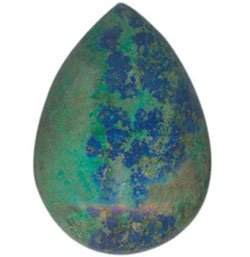 | AZURITE | Hardness | -3 to 4 | | Color | - Mixture of Blue and Green | | Origin | -Australia,Mexico & USA | | Transparency | -Opaque | | |
|
| Azurite is an intense deep blue color. Different sources claim the name is derived from the Persian word lazhward or from the Arabic word azul, both of which mean blue.
It often occurs with malachite, chrysocolla or turquoise in areas with copper deposits. A rare form called "Bluebird", has dark red Cuprite mixed with azurite. Azurite is found in Australia, Chile, France, Mexico, Morocco, Nambia, the southwestern USA, and Zaire.
For thousands of years this stone has been used in jewelry and ornamental objects. During the Middle Ages and Renaissance it was ground into pigment for use in paint and eye shadow
Azurite crystals are monoclinic, and when large enough to be seen they appear as dark blue prismatic crystals. Azurite specimens are typically massive to nodular, and are often stalactitic in form. Specimens tend to lighten in color over time due to weathering of the specimen surface into malachite. Azurite is destroyed by heat, losing carbon dioxide and water to form black, powdery copper oxide. Characteristic of a carbonate, specimens effervesce upon treatment with hydrochloric acid.
Azurite was used as a blue pigment for centuries. Depending on the degree of fineness to which it was ground, and its basic content of copper carbonate, it gave a wide range of blues. It has been known as mountain blue or Armenian stone, in addition it was formerly known as Azurro Della Magna (from Italian). When mixed with oil it turns slightly green. It is also known by the names Blue Bice and Blue Verditer. Older examples of azurite pigment may show a more greenish tint due to weathering into malachite. Much azurite was mislabeled lapis lazuli, a term applied to many blue pigments. As chemical analysis of paintings from the Middle Ages improves, azurite is being recognized as a major source of the blues used by medieval painters. True lapis lazuli was chiefly supplied from Afghanistan during the Middle Ages while azurite was a common mineral in Europe at the time. Sizable deposits were found near Lyons, France. It was mined since the 12th century in Saxony, in the silver mines located there.
|
|
|
|